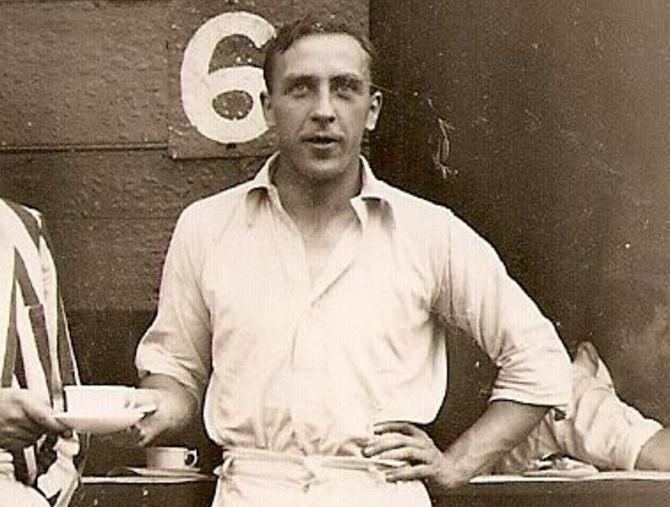Name Kenneth Gandar-Dower French Open 1R (1934) Role Aviator | Wimbledon 3R (1930, 1936) Books The Spotted Lion Wimbledon 3R (1935) Siblings Eric Gandar Dower | |
 | ||
Full name Kenneth Cecil Gandar-Dower Wimbledon 3R (1932, 1934, 1935, 1936) Parents Joseph Wilson Gandar-Dower People also search for Eric Gandar Dower, Arthur Walter Lucas, James Riddell | ||
Kenneth Cecil Gandar-Dower (31 August 1908 – 12 February 1944) was a leading English sportsman, aviator, explorer and author.
Contents
Born at his parents' home in Regent's Park, London, Gandar-Dower was the fourth and youngest son of independently wealthy Joseph Wilson Gandar-Dower and his wife Amelia Frances Germaine. Two of his elder brothers, Eric and Alan Gandar Dower, served as Conservative Members of Parliament. All used different versions of their surname: Gandar-Dower, Gandar Dower and Dower respectively.
Gandar-Dower attended Harrow School, where he played cricket, association football, Eton Fives and rackets and, with Terence Rattigan, wrote for The Harrovian. He then received a scholarship to Trinity College, Cambridge in 1927 to read History, gaining an upper second. More important, he won athletic blues in billiards, tennis and real tennis, Rugby Fives, Eton Fives and rackets. In addition, Gandar-Dower edited Granta magazine and chaired the Trinity debating society.
Sporting career
Gandar-Dower became a leading tennis player, competing in a number of tournaments throughout the 1930s, including Wimbledon and the French Championships. He was nicknamed "The undying retriever" for his ability to run large distances during matches.
At the 1932 Queen's Club Championship in London Gandar-Dower had his greatest tennis success when he defeated Harry Hopman in three sets. Newspaper reports stated that he "had Hopman perplexed with his unorthodox game and the number of astonishingly low volleys from apparently impossible positions."
Gandar-Dower also won the British Amateur Squash championships in 1938 and continued to play cricket competitively throughout the 1930s.
Gandar-Dower twice won the principal trophy in Eton Fives – the Kinnaird Cup – in 1929 and 1932, and was in the defeated pair in the 1931 final.
Gandar-Dower caused a reputation for himself in real tennis through his tactic of getting to the net as quickly as possible and volleying everything in sight. This was frowned upon by traditionalists and it was considered that Gandar-Dower "disrupted the game for a while".
Aviator
In June 1932, with minimal flying experience, Gandar-Dower entered the King's Cup Air Race and "soon became one of the most colourful aviators of his era", making one of the first flights from England to India.
Explorer
In 1934 Gandar-Dower led an expedition to Mount Kenya and the Aberdare Range in an attempt to capture a Marozi, a spotted lion rumoured to exist. While he failed to capture or photograph a marozi (which remains undiscovered), Gandar-Dower did find three sets of tracks believed to be marozi and discovered that locals differentiated marozi from lions or leopards.
He spent 1935 and 1936 in the Belgian Congo and Kenya, where he climbed active volcanoes and produced a definitive map of Mount Sattima.
Cheetah racing
Gandar-Dower returned to England in 1937 with twelve cheetahs with the intention of introducing cheetah racing to Great Britain. After six months' quarantine and six months' adapting themselves to the changed climatic conditions at Harringay and Staines stadia, the cheetahs first raced at Romford Greyhound Stadium on Saturday 11 December 1937. Specially timed trials had taken place where the cheetahs clipped seconds off almost every greyhound record. On 13 December a cheetah by the name of Helen covered the distance of 265 yards in a record time of 15.86sec but in the second race won by Gussie the second cheetah James stopped and refused to chase the hare. Helen had previously covered 355 yards in 19.8secs.
However the cheetah racing failed after just one more attempt because they were not competitive and had no interest in pursuing the hare and could not negotiate tight bends. Gandar-Dower also caused uproar at the Queen's Club when he brought a male cheetah into the bar on a leash.
Writing career
Gandar-Dower was also a successful author, writing about his adventures. His titles include:
World War II
At the outbreak of World War II Gandar-Dower was in the Belgian Congo photographing gorillas. Returning to England, he then worked on the Mass-Observation project with Tom Harrisson before being hired by the Government of Kenya to improve its public relations with the native inhabitants, producing a number of works that the government considered "excellent". Later he acted as a war correspondent, covering campaigns in Abyssinia and Madagascar, travelling vast distances by bicycle and canoe. During the un-resisted assault on Tamatave in eastern Madagascar he leapt from an amphibious vessel wearing a bowler hat, carrying a camera in one hand and typewriter in the other.
On 6 February 1944 Gandar-Dower boarded the SS Khedive Ismail at Kilindini Harbour at Mombasa, bound for Colombo. While approaching Addu Atoll in the Maldives, on 12 February 1944, the vessel was attacked by Japanese submarine I-27. Struck by two torpedoes, the Khedive Ismail sank in two minutes, with a death toll of 1297, Gandar-Dower among them.
Gandar-Dower's obituary in Wisden stated that "he was one of the most versatile player of games of any period." A wealthy man, Gandar-Dower left over £75,000 in his will.
